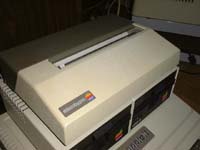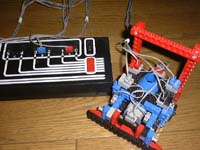 |
LEGO TC LOGO
Although the WINDOWS version of the LEGO kit has been released and I heard that
it is very popular in the US, this is the LEGO Kit for the Apple II.
1987年発売。
It was released in 1987.
ボストンのマサチューセッツ工科大学を中心としたグループにより開発された。
It was developed by a group centered on the Massachusetts Institute of
Technology in Boston. Apple IIeまたはApple
IIGS用とIBMまたはIBM-Compatible用がある。
It is made for Apple IIe or Apple IIGS and for IBM or IBM-Compatible. |
 |
Based on LEGO's Technic series, it has been designed that it is used by the LOGO
language from the PC via the interface card and interface box, sends control
signals from the LEGO motor and limit sensor to teach children how to program
and how to use the computer. |
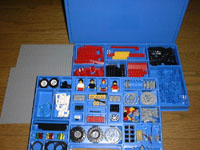 |
It is made very polite, assuming that it will actually be used in classroom.
具体的には、LEGOキット、インターフェースカード、インターフェースBox、ケーブル類などのハードと、ソフトウエア、マニュアル等からなる。
Specifically, it consists of hardware such as LEGO kit, interface card,
interface box, cables, software, manual, etc.
LEGOはブルーの取っ手付きのプラスチックケースに整然と収められるようになっている。
LEGO is arranged neatly in a blue plastic case with a handle.
マニュアルには、Reference
Guide、Teacher's
Guide、Setup
Guide、Making
Machines Guideなどなど。
In the manual, reference guide, Teacher's Guide, Setup Guide, Making Machines
Guide etc. |
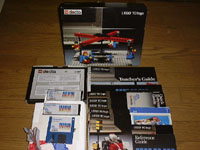 |
Two sets of manuals used by students are prepared.
例題として用意されているのは、自動車、メリーゴーランド、洗濯機、など7種類。
There are seven types, such as cars, merry-go-rounds, washing machines, etc.
that are prepared as examples.
各々についてコントロールのサンプルが用意されており、初歩的な制御から、最終的にはTurtle
Graphicsを用いてコンピュータの画面でシュミレーションを行い、実際のモデルをコントロールするなど、高度な利用ができる様に工夫されている。
Samples of control are prepared for each, from the rudimentary control,
ultimately to simulate on the screen of the computer using the Turtle Graphics.
The system has been designed to control the actual LEGO model.さらに高度な制御をするために拡張コマンドの使えるソフトウエアもオプションで用意されている。
Software for using extended commands is also available as an option for further
advanced control. |
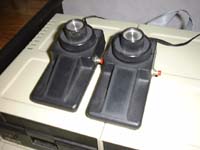 |
HAND CONTROLLERS II
The hand controller was sold as a device to connect to the 16-pin IC socket
(game I / O connector) behind the motherboard from the beginning of AppleII's
release, it was called a game paddle.
このゲームパドルには、
In this game paddle, there are various kinds.
四角いもの(色:黒、ロゴあり)
Square objects (color: black, with logo)
初期の黒色のもの(ロゴなし)
Early black ones (no logo)
ベージュカラー(ロゴあり、なし)
Beige color (with logo, none) |
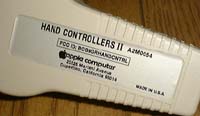 |
In the middle
ゲームパドルは途中から、ハンドコントローラと名前が変更になる。””Game
Paddle” was changed the name to “Hand Controller”.
さらに、本体がApple
II plusからApple
IIeになった時にI/Oポートが後部のCasette
Out/In端子の横に増設され、コネクターの形状も9ピンのものになり、ジョイステックやゲームパドルの接続がしやすくなった。
Furthermore, when the main body changed from Apple II plus to Apple IIe, the I /
O port was added next to the rear Casette Out / In terminal, the shape of the
connector also becomes 9 pins, it got easier to connect the joystick and game
paddle. |
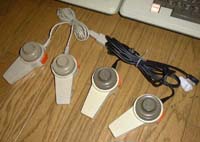 |
Since the Apple IIe has a Game I / O connector inside, it can be used as it is
with the conventional 16-pin socket using this connector. The Apple IIc had been
designed to abolish this internal connector in conjunction with expansion slots.
It is be connectable only with the new 9-pin connector. |




